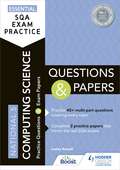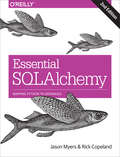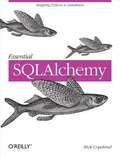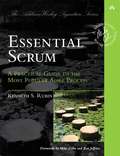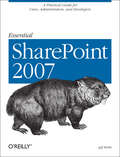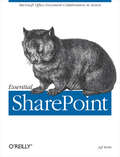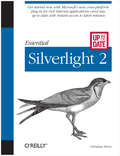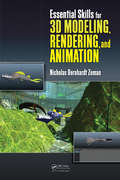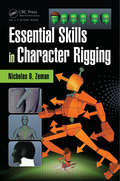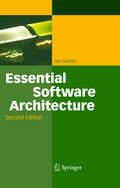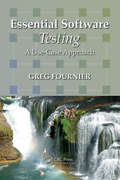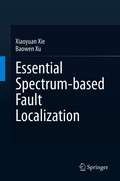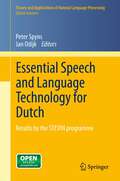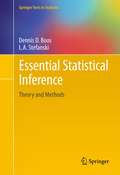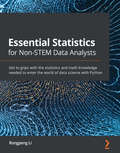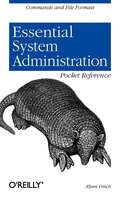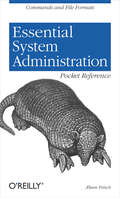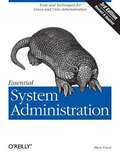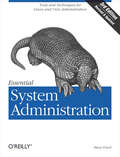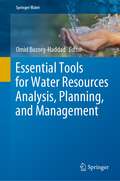- Table View
- List View
Essential SQA Exam Practice: National 5 Computing Science Questions and Papers
by Lesley RussellExam board: SQALevel: National 5Subject: Computing ScienceFirst teaching: August 2017First exam: Summer 2018Practice makes permanent. Feel confident and prepared for the SQA National 5 Computing Science exam with this two-in-one book, containing practice questions for every topic, plus two full practice papers - all written by an experienced examiner.> Choose which topics you want to revise: A simple grid enables you to pick particular areas of the course that you want to answer questions on, with solutions provided at the back of the book> Remember more in your exam: Repeated and extended practice will give you a secure knowledge of the key areas of the course (software design and development; computer systems; database design and development; web design and development)> Familiarise yourself with the exam paper: Both practice papers mirror the language and layout of the real SQA papers; complete them in timed, exam-style conditions to increase your confidence before the exams> Find out how to achieve a better grade: Answers to the practice papers have commentaries for each question, with tips on writing successful answers and avoiding common mistakesFully up to date with SQA's requirementsThe questions, mark schemes and guidance in this practice book match the requirements of the revised SQA National 5 Computing Science specification for examination from 2018 onwards.
Essential SQA Exam Practice: National 5 Computing Science Questions and Papers
by Lesley RussellExam board: SQALevel: National 5Subject: Computing ScienceFirst teaching: August 2017First exam: Summer 2018Practice makes permanent. Feel confident and prepared for the SQA National 5 Computing Science exam with this two-in-one book, containing practice questions for every topic, plus two full practice papers - all written by an experienced examiner.> Choose which topics you want to revise: A simple grid enables you to pick particular areas of the course that you want to answer questions on, with solutions provided at the back of the book> Remember more in your exam: Repeated and extended practice will give you a secure knowledge of the key areas of the course (software design and development; computer systems; database design and development; web design and development)> Familiarise yourself with the exam paper: Both practice papers mirror the language and layout of the real SQA papers; complete them in timed, exam-style conditions to increase your confidence before the exams> Find out how to achieve a better grade: Answers to the practice papers have commentaries for each question, with tips on writing successful answers and avoiding common mistakesFully up to date with SQA's requirementsThe questions, mark schemes and guidance in this practice book match the requirements of the revised SQA National 5 Computing Science specification for examination from 2018 onwards.
Essential SQLAlchemy
by Rick Copeland Jason MyersDive into SQLAlchemy, the popular, open-source code library that helps Python programmers work with relational databases such as Oracle, MySQL, PostgresSQL, and SQLite. Using real-world examples, this practical guide shows you how to build a simple database application with SQLAlchemy, and how to connect to multiple databases simultaneously with the same metadata.SQL is a powerful language for querying and manipulating data, but it's tough to integrate it with your application. SQLAlchemy helps you map Python objects to database tables without substantially changing your existing Python code. If you're an intermediate Python developer with knowledge of basic SQL syntax and relational theory, this book serves as both a learning tool and a handy reference.Essential SQLAlchemy includes several sections:SQLAlchemy Core: Provide database services to your applications in a Pythonic way with the SQL Expression LanguageSQLAlchemy ORM: Use the object relational mapper to bind database schema and operations to data objects in your applicationAlembic: Use this lightweight database migration tool to handle changes to the database as your application evolvesCookbook: Learn how to use SQLAlchemy with web frameworks like Flask and libraries like SQLAcodegen
Essential SQLAlchemy
by Rick CopelandEssential SQLAlchemy introduces a high-level open-source code library that makes it easier for Python programmers to access relational databases such as Oracle, DB2, MySQL, PostgreSQL, and SQLite. SQLAlchemy has become increasingly popular since its release, but it still lacks good offline documentation. This practical book fills the gap, and because a developer wrote it, you get an objective look at SQLAlchemy's tools rather than an advocate's description of all the "cool" features. SQLAlchemy includes both a database server-independent SQL expression language and an object-relational mapper (ORM) that lets you map "plain old Python objects" (POPOs) to database tables without substantially changing your existing Python code. Essential SQLAlchemy demonstrates how to use the library to create a simple database application, walks you through simple queries, and explains how to use SQLAlchemy to connect to multiple databases simultaneously with the same Metadata. You also learn how to:Create custom types to be used in your schema, and when it's useful to use custom rather than built-in types Run queries, updates, and deletes with SQLAlchemy's SQL expression language Build an object mapper with SQLAlchemy, and understand the differences between this and active record patterns used in other ORMs Create objects, save them to a session, and flush them to the database Use SQLAlchemy to model object oriented inheritance Provide a declarative, active record pattern for use with SQLAlchemy using the Elixir extension Use the SQLSoup extension to provide an automatic metadata and object model based on database reflection In addition, you'll learn how and when to use other extensions to SQLAlchemy, including AssociationProxy, OrderingList, and more.Essential SQLAlchemy is the much-needed guide for every Python developer using this code library. Instead of a feature-by-feature documentation, this book takes an "essentials" approach that gives you exactly what you need to become productive with SQLAlchemy right away.
Essential SQLAlchemy: Mapping Python to Databases
by Rick Copeland Jason MyersDive into SQLAlchemy, the popular, open-source code library that helps Python programmers work with relational databases such as Oracle, MySQL, PostgresSQL, and SQLite. Using real-world examples, this practical guide shows you how to build a simple database application with SQLAlchemy, and how to connect to multiple databases simultaneously with the same metadata.SQL is a powerful language for querying and manipulating data, but it’s tough to integrate it with your application. SQLAlchemy helps you map Python objects to database tables without substantially changing your existing Python code. If you’re an intermediate Python developer with knowledge of basic SQL syntax and relational theory, this book serves as both a learning tool and a handy reference.Essential SQLAlchemy includes several sections:SQLAlchemy Core: Provide database services to your applications in a Pythonic way with the SQL Expression LanguageSQLAlchemy ORM: Use the object relational mapper to bind database schema and operations to data objects in your applicationAlembic: Use this lightweight database migration tool to handle changes to the database as your application evolvesCookbook: Learn how to use SQLAlchemy with web frameworks like Flask and libraries like SQLAcodegen
Essential Scrum: A Practical Guide to the Most Popular Agile Process
by Kenneth RubinEssential Scrum will provide every team member, manager, and executive with a common understanding of Scrum, a shared vocabulary they can use in applying it, and practical knowledge for deriving maximum value from it. Whether you are new to Scrum or years into your use, this book will introduce, clarify, and deepen your Scrum knowledge at the team, product, and portfolio levels. Drawing from Rubin’s experience helping hundreds of organizations succeed with Scrum, this book provides easy-to-digest descriptions enhanced by more than two hundred illustrations based on an entirely new visual icon language for describing Scrum’s roles, artifacts, and activities. Essential Scrum is the complete, single-source reference to develop innovative products and services that delight your customers.
Essential SharePoint 2007, 2nd Edition
by Jeff WebbIf you're considering the vastly improved 2007 version of SharePoint, this concise, practical and friendly guide will teach you how to get the most from the latest version of Microsoft's information-sharing and collaboration platform. Essential SharePoint 2007 demonstrates how your business can use SharePoint to control documents, structure workflow, and share information over the Web using standard tools business users already know -- Microsoft Office and Internet Explorer. Written in a conversational tone by internationally recognized SharePoint consultant and trainer Jeff Webb, this book helps SharePoint administrators, site owners, and power users quickly gain the skills necessary to perform a wide variety of tasks for intranet and extranet web sites, and explains what's new in SharePoint 2007 for experienced SharePoint 2003 administrators. Essential SharePoint 2007 teaches you how to: * Use SharePoint 2007 with Outlook, Word and Excel, and as a document management tool, replacing, for example, shared network drives with libraries * Build and customize sites, lists, libraries and web parts for intranets and extranets * Use SharePoint 2007 for team communication through blogs, wikis, surveys, and RSS and email alerts * Build a SharePoint workflow application * Create and program web parts in order to deliver custom services and data to a site * Deploy and administer SharePoint 2007 Each chapter ends with a summary of best practices advocated by the author, and the first few chapters of the book are ideal as training materials for end users. Later chapters give developers and administrators tools not only to keep company sites running smoothly, but also to customize and extend them. The book also contains several appendices with a glossary of terms and hard-to-find information. Essential SharePoint 2007 is a one-stop task-oriented guide for learning what's necessary to make this tool a vital part of team productivity.
Essential SharePoint 2007: A Practical Guide for Users, Administrators and Developers
by Jeff WebbIf you're considering the vastly improved 2007 version of SharePoint, this concise, practical and friendly guide will teach you how to get the most from the latest version of Microsoft's information-sharing and collaboration platform. Essential SharePoint 2007 demonstrates how your business can use SharePoint to control documents, structure workflow, and share information over the Web using standard tools business users already know -- Microsoft Office and Internet Explorer.Written in a conversational tone by internationally recognized SharePoint consultant and trainer Jeff Webb, this book helps SharePoint administrators, site owners, and power users quickly gain the skills necessary to perform a wide variety of tasks for intranet and extranet web sites, and explains what's new in SharePoint 2007 for experienced SharePoint 2003 administrators. Essential SharePoint 2007 teaches you how to:Use SharePoint 2007 with Outlook, Word and Excel, and as a document management tool, replacing, for example, shared network drives with librariesBuild and customize sites, lists, libraries and web parts for intranets and extranetsUse SharePoint 2007 for team communication through blogs, wikis, surveys, and RSS and email alertsBuild a SharePoint workflow applicationCreate and program web parts in order to deliver custom services and data to a siteDeploy and administer SharePoint 2007Each chapter ends with a summary of best practices advocated by the author, and the first few chapters of the book are ideal as training materials for end users. Later chapters give developers and administrators tools not only to keep company sites running smoothly, but also to customize and extend them. The book also contains several appendices with a glossary of terms and hard-to-find information.Essential SharePoint 2007 is a one-stop task-oriented guide for learning what's necessary to make this tool a vital part of team productivity.
Essential SharePoint: Microsoft Office Document Collaboration in Action
by Jeff WebbWant to work more efficiently and effectively? Want to improve productivity? Microsoft is betting that you do. That's why it created Windows SharePoint Services--a set of collaboration tools that helps organizations increase individual and team productivity by enabling them to create web sites for information sharing and document collaboration.Through these team-oriented web sites, users capture and share ideas, and work together on documents, tasks, contacts, etc.--either among themselves or with partners and customers. And if you have Windows 2003 Server, then you already have SharePoint, since it's built right in. But before you can enjoy the benefits of SharePoint, you need to know how to turn it on, set it up, and get your applications working with it.Essential Sharepoint will help you do just that. It's not only the most complete guide for setting up and using these increasingly popular sites, but it also explains in detail the integration that makes SharePoint exciting. Everything you need to know about SharePoint is covered, including:hosting choicesadministrationcustomizationintegration with Microsoft Officedeveloping new SharePoint functionalitywhen to use SharePoint portal serverEssential Sharepoint covers all the key topics for getting up and running with this powerful and popular set of collaboration tools. And it's not just for members of the IT staff. This comprehensive guide is for anyone in an organization who wants to explore Microsoft SharePoint in order to foster collaboration with other users.
Essential Silverlight 2 Up-to-Date
by Christian WenzDesign rich Internet applications (RIAs) for the Web using Silverlight 2, Microsoft's hot runtime application. Available only as an ebook, this concise, easy-to-understand introduction provides complete step-by-step instructions for using everything Silverlight 2 has to offer, including tools for animation, vector graphics, video playback, .NET support for web services and networking, as well as LINQ, Microsoft's native data querying tool. Essential Silverlight 2 helps you take advantage of Microsoft's cross-browser plug-in with:Clever ways to create interactive UIs that are more robust and easier to debug and test than what you can achieve on other platformsScores of tested JavaScript and C# code examples that you can reuse in your own applicationsExpert guidance from an author who understands RIA technologies, including ASP.NET, Flash, PHP, and JavaScriptReady to deliver a more complete Web experience? Essential Silverlight 2 offers a world of possibilities.
Essential Skills for 3D Modeling, Rendering, and Animation
by Nicholas Bernhardt ZemanThe Key to Fully Understanding the Basics of a 3D WorldProminently used in games, movies, and on television, 3D graphics are tools of creation used to enhance how material and light come together to manipulate objects in 3D space. A game-changer written for the non-technical mind, Essential Skills for 3D Modeling, Rendering, and Animation examines
Essential Skills in Character Rigging
by Nicholas B. ZemanCharacter rigging is the method with which you create a system for animating a character. A rig is represented by two primary mechanics: the skeleton, consisting of hierarchical rotations to drive the motions, and a skin, or method of deforming the geometry that makes up the character model. Essential Skills in Character Rigging is a beginner's gui
Essential Skills in Organic Modeling
by Nicholas B. ZemanThis is a beginner’s guide to learning and implementing the essential aspects of modeling organic objects and using an organic workflow to model anything. This book gives an aspiring modeler all the tools that they need to know in order to begin creating great models that are efficient and laid out properly for rigging and texturing. The reader will be taken through all the primary techniques and methodologies for making “liveable” creatures for video, film, or games. The reader will also learn the basic physical structure that designates something as organic vs artificial, and how these varying structures can be tackled from a modeling perspective.through a practical, hands-on approach. Features Designed to approach organic modeling in a software-independent manner. Builds fundamental knowledge of 3D digital art from the ground up. Each lesson builds on the previous lesson. Has industry standard knowledge, based on simplicity and efficiency that will work for either production rendering or game development. Defines what organic modeling is and how it works, and why each technique was developed and implemented as it currently stands.
Essential Software Architecture
by Ian GortonJob titles like "Technical Architect" and "Chief Architect" nowadays abound in software industry, yet many people suspect that "architecture" is one of the most overused and least understood terms in professional software development. Gorton's book tries to resolve this dilemma. It concisely describes the essential elements of knowledge and key skills required to be a software architect. The explanations encompass the essentials of architecture thinking, practices, and supporting technologies. They range from a general understanding of structure and quality attributes through technical issues like middleware components and service-oriented architectures to recent technologies like model-driven architecture, software product lines, aspect-oriented design, and the Semantic Web, which will presumably influence future software systems. This second edition contains new material covering enterprise architecture, agile development, enterprise service bus technologies, RESTful Web services, and a case study on how to use the MeDICi integration framework. All approaches are illustrated by an ongoing real-world example. So if you work as an architect or senior designer (or want to someday), or if you are a student in software engineering, here is a valuable and yet approachable knowledge source for you.
Essential Software Testing: A Use-Case Approach
by Greg FournierA Practical Guide to Software TestingMuch has been written about the difficulty of software testing. Often these laments are accompanied by cautionary words about how careful one has to be to ensure testing is done properly. However, there is a dearth of resources that give practical guidance on the nuts and bolts of testing. Essential Software Tes
Essential Spectrum-based Fault Localization
by Xiaoyuan Xie Baowen XuProgram debugging has always been a difficult and time-consuming task in the context of software development, where spectrum-based fault localization (SBFL) is one of the most widely studied families of techniques. While it’s not particularly difficult to learn about the process and empirical performance of a particular SBFL technique from the available literature, researchers and practitioners aren’t always familiar with the underlying theories. This book provides the first comprehensive guide to fundamental theories in SBFL, while also addressing some emerging challenges in this area. The theoretical framework introduced here reveals the intrinsic relations between various risk evaluation formulas, making it possible to construct a formula performance hierarchy. Further extensions of the framework provide a sufficient and necessary condition for a general maximal formula, as well as performance comparisons for hybrid SBFL methods. With regard to emerging challenges in SBFL, the book mainly covers the frequently encountered oracle problem in SBFL and introduces a metamorphic slice-based solution. In addition, it discusses the challenge of multiple-fault localization and presents cutting-edge approaches to overcoming it. SBFL is a widely studied research area with a massive amount of publications. Thus, it is essential that the software engineering community, especially those involved in program debugging, software maintenance and software quality assurance (including both newcomers and researchers who want to gain deeper insights) understand the most fundamental theories – which could also be very helpful to ensuring the healthy development of the field.
Essential Speech and Language Technology for Dutch: Results by the STEVIN-programme (Theory and Applications of Natural Language Processing #14)
by Peter Spyns Linde Van Bosch Jan OdijkThe book provides an overview of more than a decade of joint R&D efforts in the Low Countries on HLT for Dutch. It not only presents the state of the art of HLT for Dutch in the areas covered, but, even more importantly, a description of the resources (data and tools) for Dutch that have been created are now available for both academia and industry worldwide. The contributions cover many areas of human language technology (for Dutch): corpus collection (including IPR issues) and building (in particular one corpus aiming at a collection of 500M word tokens), lexicology, anaphora resolution, a semantic network, parsing technology, speech recognition, machine translation, text (summaries) generation, web mining, information extraction, and text to speech to name the most important ones. The book also shows how a medium-sized language community (spanning two territories) can create a digital language infrastructure (resources, tools, etc.) as a basis for subsequent R&D. At the same time, it bundles contributions of almost all the HLT research groups in Flanders and the Netherlands, hence offers a view of their recent research activities. Targeted readers are mainly researchers in human language technology, in particular those focusing on Dutch. It concerns researchers active in larger networks such as the CLARIN, META-NET, FLaReNet and participating in conferences such as ACL, EACL, NAACL, COLING, RANLP, CICling, LREC, CLIN and DIR ( both in the Low Countries), InterSpeech, ASRU, ICASSP, ISCA, EUSIPCO, CLEF, TREC, etc. In addition, some chapters are interesting for human language technology policy makers and even for science policy makers in general.
Essential Statistical Inference
by Dennis D. Boos L A StefanskiThis book is for students and researchers who have had a first year graduate level mathematical statistics course. It covers classical likelihood, Bayesian, and permutation inference; an introduction to basic asymptotic distribution theory; and modern topics like M-estimation, the jackknife, and the bootstrap. R code is woven throughout the text, and there are a large number of examples and problems. An important goal has been to make the topics accessible to a wide audience, with little overt reliance on measure theory. A typical semester course consists of Chapters 1-6 (likelihood-based estimation and testing, Bayesian inference, basic asymptotic results) plus selections from M-estimation and related testing and resampling methodology. Dennis Boos and Len Stefanski are professors in the Department of Statistics at North Carolina State. Their research has been eclectic, often with a robustness angle, although Stefanski is also known for research concentrated on measurement error, including a co-authored book on non-linear measurement error models. In recent years the authors have jointly worked on variable selection methods.
Essential Statistics for Non-STEM Data Analysts: Get to grips with the statistics and math knowledge needed to enter the world of data science with Python
by Rongpeng LiReinforce your understanding of data science and data analysis from a statistical perspective to extract meaningful insights from your data using Python programmingKey FeaturesWork your way through the entire data analysis pipeline with statistics concerns in mind to make reasonable decisionsUnderstand how various data science algorithms functionBuild a solid foundation in statistics for data science and machine learning using Python-based examplesBook DescriptionStatistics remain the backbone of modern analysis tasks, helping you to interpret the results produced by data science pipelines. This book is a detailed guide covering the math and various statistical methods required for undertaking data science tasks. The book starts by showing you how to preprocess data and inspect distributions and correlations from a statistical perspective. You'll then get to grips with the fundamentals of statistical analysis and apply its concepts to real-world datasets. As you advance, you'll find out how statistical concepts emerge from different stages of data science pipelines, understand the summary of datasets in the language of statistics, and use it to build a solid foundation for robust data products such as explanatory models and predictive models. Once you've uncovered the working mechanism of data science algorithms, you'll cover essential concepts for efficient data collection, cleaning, mining, visualization, and analysis. Finally, you'll implement statistical methods in key machine learning tasks such as classification, regression, tree-based methods, and ensemble learning. By the end of this Essential Statistics for Non-STEM Data Analysts book, you'll have learned how to build and present a self-contained, statistics-backed data product to meet your business goals.What you will learnFind out how to grab and load data into an analysis environmentPerform descriptive analysis to extract meaningful summaries from dataDiscover probability, parameter estimation, hypothesis tests, and experiment design best practicesGet to grips with resampling and bootstrapping in PythonDelve into statistical tests with variance analysis, time series analysis, and A/B test examplesUnderstand the statistics behind popular machine learning algorithmsAnswer questions on statistics for data scientist interviewsWho this book is forThis book is an entry-level guide for data science enthusiasts, data analysts, and anyone starting out in the field of data science and looking to learn the essential statistical concepts with the help of simple explanations and examples. If you're a developer or student with a non-mathematical background, you'll find this book useful. Working knowledge of the Python programming language is required.
Essential System Administration Pocket Reference
by 198 Leen FrischThis pocket reference brings together all the important Unix and Linux system administration information in a single compact volume. Not only are all of the important administrative commands covered, but this reference also includes the locations and formats of important configuration files (including both general system databases like the password and group files as well as the configuration files for major subsystems like DNS, DHCP and sendmail). In addition, variations in command usage and file formats a
Essential System Administration Pocket Reference
by Æleen FrischIf you're a Unix system administrator, then the information you need every day just to get your job done could fill a book--a very large book. But, practically speaking, you don't want to stop and thumb through a weighty volume each time a problem arises. Your answer is the Essential System Administration Pocket Reference , the only system administration reference that fits in your pocket. Concise and easy-to-use, this little book is the portable companion to the classic Essential System Administration by Æleen Frisch. The Essential System Administration Pocket Reference is a quick reference to all the fundamental and essential tasks required to run such divergent Unix systems as Solaris, Linux, AIX, BSD, SuSe, Red Hat, and more. Beginners and experienced administrators alike will quickly be able to apply its principles and advice to solve everyday problems. The book is divided into three parts: Commands, Syntax and Their Applications, Configuration Files and Formats, and Operating System Specific Information. The information in this book is a must-have for any administrator or user of a Unix system. O'Reilly's Pocket References have become a favorite among technology professionals everywhere. By providing a wealth of important details in a concise, well-organized format, these handy books deliver just what you need to complete the task at hand. When you've reached a sticking point and need to get to a solution quickly, the new Essential System Administration Pocket Reference is the book you'll want to have.
Essential System Administration Pocket Reference: Commands and File Formats
by Æleen FrischIf you're a Unix system administrator, then the information you need every day just to get your job done could fill a book--a very large book. But, practically speaking, you don't want to stop and thumb through a weighty volume each time a problem arises. Your answer is the Essential System Administration Pocket Reference, the only system administration reference that fits in your pocket. Concise and easy-to-use, this little book is the portable companion to the classic Essential System Administration by AEleen Frisch.The Essential System Administration Pocket Reference is a quick reference to all the fundamental and essential tasks required to run such divergent Unix systems as Solaris, Linux, AIX, BSD, SuSe, Red Hat, and more. Beginners and experienced administrators alike will quickly be able to apply its principles and advice to solve everyday problems. The book is divided into three parts: Commands, Syntax and Their Applications, Configuration Files and Formats, and Operating System Specific Information. The information in this book is a must-have for any administrator or user of a Unix system.O'Reilly's Pocket References have become a favorite among technology professionals everywhere. By providing a wealth of important details in a concise, well-organized format, these handy books deliver just what you need to complete the task at hand. When you've reached a sticking point and need to get to a solution quickly, the new Essential System Administration Pocket Reference is the book you'll want to have.
Essential System Administration, 3rd Edition
by Leen FrischWhether you use a standalone Unix system, routinely provide administrative support for a larger shared system, or just want an understanding of basic administrative functions, Essential System Administrationis for you. This comprehensive and invaluable book combines the author's years of practical experience with technical expertise to help you manage Unix systems as productively and painlessly as possible.
Essential System Administration: Tools and Techniques for Linux and Unix Administration
by Æleen FrischEssential System Administration,3rd Edition is the definitive guide for Unix system administration, covering all the fundamental and essential tasks required to run such divergent Unix systems as AIX, FreeBSD, HP-UX, Linux, Solaris, Tru64 and more. Essential System Administration provides a clear, concise, practical guide to the real-world issues that anyone responsible for a Unix system faces daily.The new edition of this indispensable reference has been fully updated for all the latest operating systems. Even more importantly, it has been extensively revised and expanded to consider the current system administrative topics that administrators need most. Essential System Administration,3rd Edition covers: DHCP, USB devices, the latest automation tools, SNMP and network management, LDAP, PAM, and recent security tools and techniques.Essential System Administration is comprehensive. But what has made this book the guide system administrators turn to over and over again is not just the sheer volume of valuable information it provides, but the clear, useful way the information is presented. It discusses the underlying higher-level concepts, but it also provides the details of the procedures needed to carry them out. It is not organized around the features of the Unix operating system, but around the various facets of a system administrator's job. It describes all the usual administrative tools that Unix provides, but it also shows how to use them intelligently and efficiently.Whether you use a standalone Unix system, routinely provide administrative support for a larger shared system, or just want an understanding of basic administrative functions, Essential System Administration is for you. This comprehensive and invaluable book combines the author's years of practical experience with technical expertise to help you manage Unix systems as productively and painlessly as possible.
Essential Tools for Water Resources Analysis, Planning, and Management (Springer Water)
by Omid Bozorg-HaddadThis book describes concepts and tools needed for water resources management, including methods for modeling, simulation, optimization, big data analysis, data mining, remote sensing, geographical information system, game theory, conflict resolution, System dynamics, agent-based models, multiobjective, multicriteria, and multiattribute decision making and risk and uncertainty analysis, for better and sustainable management of water resources and consumption, thus mitigating the present and future global water shortage crisis. It presents the applications of these tools through case studies which demonstrate its benefits of proper management of water resources systems. This book acts as a reference for students, professors, industrial practitioners, and stakeholders in the field of water resources and hydrology.
